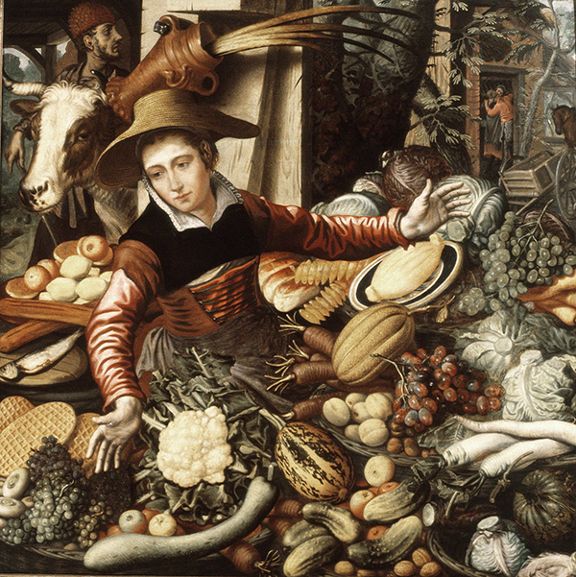Gem of the Month: Pieter Aertsen
I have presented quite a few posts about still-life painting over the years because (1) I like doing still life paintings myself and (2) still life is one of the first types of painting lessons many young art students experience. However, still life was not always considered a “venerable” subject for professional artists in Western art. History painting, religious subjects, and portraiture were the primary subjects that earned artists patronage before the Baroque period (ca. 1600–1750). Still-life imagery began to worm its way into painting during the Renaissance (ca. 1300–1600) when it was used as vehicle for “hidden symbolism,” mostly in religious paintings. It blossomed into its own during the 1500s, when many Northern Renaissance artists moved away from religious imagery in art due to the Reformation and focused on recognizable elements of the physical world that so interested art patrons from the growing middle class. Around 1550, Pieter Aertsen exploded the importance of still life in huge genre paintings in which still-life arrangements of foods dominated the composition.
 |
| Pieter Aertsen (1507/1508–1575, Netherlands), Market Woman at a Vegetable Stand, ca. 1567. Oil on wood, 43 ¾" x 43 5⁄16" (111 x 110 cm). Gemäldegalerie (Stiftung Preussischer Kulturbesitz), Berlin. Photo © 2024 Dr Ronald V. Wiedenhoeft/Saskia, Ltd. (LHF-0175) |
Aertsen is credited with being one of the first painters who sublimated religious or moral subjects with massive still-life genre compositions. He may have been influenced by earlier Antwerp painter Joachim Patinir (1483–1524). In Market Woman at a Vegetable Stand, Aertsen presents a ponderous still life of fruits, vegetables, breads, and fish that dwarf the female figure in importance, particularly because of the bright colors and meticulously drawn physical details in the life-sized fruits and vegetables. This prefigures Dutch and Flemish still-life paintings of the 1600s, in which such heavily laden tables of food are sometimes nicknamed "groaning board" or "banquet" pieces.
The foods that exaggeratedly dominate Market Woman at a Vegetable Stand contribute to the moral of the work. The woman’s left arm sweeps upward as if indicating the bounty of the prosperous Lowlands. The pile of humble, not exotic, foods and the upward sweep of arm lead the viewer’s eye to a rural country couple kissing in the doorway of a house. Poor people of the country were stereotyped as crude and full of lust, so this painting becomes a comparison with what is the worse sin: coveting the large bounty of visually enticing, earthly foods (i.e., gluttony) or the carnal activity in the background. In case the viewer misses the background scene of kissing, the male figure in the upper left gazes critically across the painting at the couple. The duality of meaning in objects and people is a continuation of the Northern Renaissance practice of “hidden symbolism,” moral or religious lessons couched in everyday objects.
The Late Renaissance (ca. 1540–1600) style in painting was characterized by conscious rejection of Renaissance principles of balance, symmetry, and classical beauty in the work of many artists throughout Europe. Present-day Netherlands, Belgium, and Luxembourg (the “Low Countries”) were occupied by the Spanish from the 1550s until the early 1700s, partly in order to restore the Roman Church’s dominance over religion after the Protestant Reformation, and partly to reap the taxes of the wealthy merchant class that ran the Low Countries. The Spanish occupation caused constant religious and secular uprisings and violence. In such a turbulent period, the interest in courtly style from Flanders and Burgundy waned in the Netherlands in favor an emphasis on physical realism.
By the 1520s in the Low Countries, Antwerp had usurped Bruges’s position as the trading capital of Northern Europe after Bruges's Zwin channel had silted over. Antwerp's affluence was due to economic and political factors. Merchants from all over Europe established their international offices there, and the Hapsburgs, rulers of the Holy Roman Empire, deposited their wealth there. The Hapsburgs had replaced Burgundy as the political power in the Low Countries, and it was in Antwerp that the art market was vigorously promoted.
Painting in the first decades of the 1500s in Antwerp was a hodgepodge of styles and references from ancient Roman architecture to fanciful costumes to Mannerism. Romanism is a term used to describe some Flemish and Dutch painting. There was no major transformation overall of the super realistic northern style, but certain elements of Italian Renaissance art were adopted and molded to fit the distinctive Flemish style.
Aertsen was born and died in Amsterdam. He was an apprentice to the Mannerist painter Aert Claesz (Aertgen van Leyden, ca. 1498–ca. 1564), a painter in Leiden. Aertsen painted religious works throughout his career, although many of them were destroyed during the Netherlands's conversion to Protestantism. After his apprenticeship, Aertsen went to Antwerp, where he became a member of the city's painters' guild in 1542. He returned to Amsterdam around 1555. Aertsen's formula for painting still life that dwarfed either a landscape or genre subject had great impact on the development of still-life painting in the Flemish and Dutch Baroque periods (ca. 1600–1750). His children, Dirk, Pieter, and Aert, all became acclaimed artists, as did his pupil Joachim Beuckelaer (1533–1574), who carried on his format of giant still-life compositions dominating all else.
Correlations to Davis programs: Explorations in Art 2E Grade 1: 1.5; Explorations in Art 2E Grade 2: 5.4; Explorations in Art 2E Grade 4: 6.8; Explorations in Art 2E Grade 5: 2.3; Explorations in Art 2E Grade 6: 1.8; Experience Art: pp. 82–83; A Global Pursuit 2E: 5.2, 5.3; A Personal Journey 2E: 2.6; Exploring Painting 3E: Chapter 9; Discovering Drawing 3E: Chapter 3

Comments